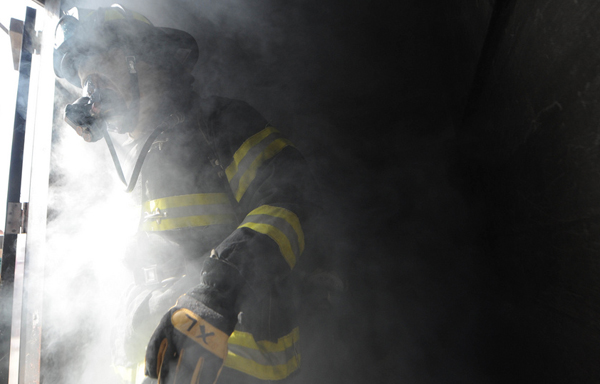
Photo by: Todd Maisel/Courtesy IAFF
Firefighters’ bunker gear protects them from intense heat. But it also very heavy, contributing to the physical exertion that elevates the heart attack risk associated with firefighting.
There were 138 firefighters from 33 companies battling the Aug. 28, 2001, fire at the L&S Collision Auto Body shop in Port Richmond, Staten Island, when one of them—27-year-old Michael Gorumba—began to have difficulty breathing. He walked back to his company’s engine, sat down and died.
Gorumba was one of eight FDNY members to succumb to heart trouble from 1991 to now. Separately, the 2008 death of Jamel Sears, a 33-year-old who collapsed after a training exercise, was blamed on dehydration, but a heart condition contributed. The FDNY’s most recent line-of-duty death, which claimed Paul Warhola in 2009, was caused by a stroke.
Heart attacks are the single largest threat to firefighters’ lives. According to the United States Fire Association, 44 percent of all line-of-duty firefighter deaths from 1995 to 2004 were heart-related. Several aspects of firefighting contribute to elevated cardiac risk. One is smoke: Both carbon monoxide and hydrogen cyanide can cause heart disease and are present in the air even during the overhaul stage of a fire, when many firefighters remove their breathing gear. Another is exertion: Not only do firefighters have to perform extremely difficult tasks, but they also must switch instantly from sitting peacefully to rushing around with heavy gear, under circumstances in which fear and stress raise their blood pressure, perhaps after they have been on duty for up to 24 hours. Even the noise that firefighters are subjected to (screaming sirens, whining roof saws, crackling radios) might contribute to heart strain.
Heat stress can also cause heart attacks, and fighting fires is hot work. The heavy gear fire-fighters wear makes even the ride to a fire a heat-stress risk. “Our core temperature is heating up before we get to the box,” says retired FDNY battalion chief Jerry Tracey. “Our core temperature can be 99 or 100 degrees before we go into a building to fight the fire.” (It was 88 degrees the day Gorumba died.)
To reduce the risk of heart attack, the CDC recommends that fire departments take steps to cool down firefighters, providing breaks and rehydrating them. “Rehab is a big buzzword,” says retired FDNY lieutenant Steve Mormino, from the National Firefighter Near Miss Reporting System. Actually, there are three buzzwords—rehab, re-evaluate, rehydrate. Some departments are bringing misters and special cooling chairs to fire scenes.
According to its current strategic plan, the FDNY is providing stricter heart screenings as part of the annual medical checkup firefighters receive, setting up cardiac health and smoking-cessation programs and planning new efforts to address dehydration and heat exhaustion. Department spokesman Frank Gribbon says the department is in the process of obtaining mis-ters and cooling chairs.
But recent budget cuts that reduce personnel in some fire companies could have health consequences: The CDC recommends that fire departments “ensure adequate staffing levels for operations to prevent overexertion.” And one local fire union official notes that “rehab starts before a fire”—in other words, with the rest you take between calls. Between training and building inspections, firefighters gripe that they don’t get a lot of downtime these days.
Gorumba had a heart murmur, but that’s not what killed him. The National Institute for Occupational Safety and Health blamed a second heart problem called hypertrophic cardiomyopathy. Gorumba had never experienced any heart symptoms, and the FDNY didn’t detect the condition when he joined the department, probably because it was at such an early stage. Even if it had been detected, it’s not clear that Gorumba would have been barred from the fire department or that his death could have been avoided, because it’s difficult to distinguish cardiomyopathy cases that are serious enough to require treatment from those that aren’t.
The only thing that might have saved Gorumba is if he had received medical attention earlier. His colleagues initially thought he was missing inside the fire building. It took five to 10 minutes for him to be found in the fire truck, delaying CPR. “Fire fighters need to recognize the importance of any unusual symptoms, report these symptoms to their officers, and inform their co-workers and superiors about their intentions to relocate. Likewise, crew members need to maintain constant contact with their assigned ‘buddy,’ ” the report concluded.








